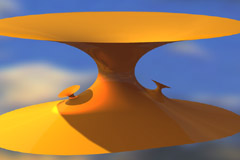|
|
Touching Soap Films |
|
|
|
Controlled Modification of Surfaces
Requisite control of minimal surfaces out to infinity was developed based on Osserman's work on the Weierstraß representation. Out of this work one succeeded in a very clear way in changing even already known surfaces, making them more complicated, even though this change has an easily visible effect on only a small part of the surface. This success appears to contradict the above described ,inheritability' property of minimal surfaces, which usually react in the form of catastrophic perturbations at a greater distance from a place where small changes are made. Mathematicians did not expect an abundance of new examples because of this effect. Luquesio P. Jorge of Ceara Federal University (Brazil) and William M. Meeks III of the University of Massachusetts at Amherst (USA), were the first who-starting from the imagined shape of the surface to be newly constructed-undertook the controlled alteration of a minimal surface out to infinity. Out of the two funnel-shaped ends into which the catenoid spreads out, they made three ends. From this approximate representation, along with Osserman' s theory, they concluded in 1980 with the Weierstraß representation formula for a new minimal surface: the trinoid, in which three ends are fitted together. Today we can build new ends at arbitrary places on the catenoid. The bidenoid in Fig 12 has two additional tiny ends on the lower portion of the catenoid. These new complete minimal surfaces are, however, not embedded, since they intersect themselves, as one can see as soon as one observes a larger portion of the minimal surface. The ends of the trinoid intersect each other. Also the little ends of the bidenoid cut the remaining surface. In the case of embedded minimal surfaces, on the one hand, since long ago periodic surfaces like the helicoid as well as the Scherk surface and the surfaces of Schwarz were known; but on the other hand, only two non-periodic surfaces-the plane and the catenoid-were known. It was expected that these two were indeed the only two such surfaces. In any case, nobody was able to suggest what geometrical form a third candidate surface might have - until the famous Costa-Hoffman-Meeks surface was discovered (Fig 3). |
